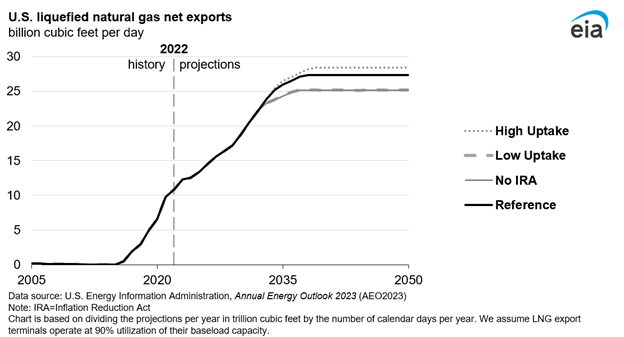EIA: U.S. To Remain Net Energy Exporter Through 2050
The Energy Information Administration’s 2023 Annual Energy Outlook (AEO) projects U.S. energy production to remain high, exports to grow, and natural gas consumption to remain stable as renewable energies integrate onto the grid through 2050. The combination of increased energy efficiency, including upgrades from simple cycle natural gas turbines to combined cycle natural gas turbines, and increased renewables result in a projected 25-38 percent reduction in energy-sector related CO2 emissions below 2005 levels by 2030.
A Net Exporter Through 2050
In 2022, the United States tied Qatar as the world’s largest exporter of liquified natural gas, and the EIA expects U.S. energy exports to grow with the increased demand for LNG through 2050. In the last year alone exports grew 9 percent, and international demand is expected to continue into the future, keeping U.S. production at historic highs.

LNG growth along the Gulf Coast is already preparing for an increase in export capacity with 169 million metric tons being brought online by 2027, and an additional 54.5 million tons of capacity in line for review this year. This growth is expected to continue: EIA projects LNG exports in 2050 to total between 27 to 28 billion cubic feet per day – more than 2.5 times capacity in 2022. Even in the Low Uptake case, LNG exports increase 2.3 times over their 2022 levels.
The increase in exports means growth in domestic natural gas production in most cases, with the EIA’s reference case forecasting a 15 percent increase in natural gas production from 2022 to 2050. And in all cases, domestic production outpaces domestic consumption.
Emission Reductions
By 2050, total energy-related CO2 emissions are set to decrease 17 percent despite GDP and population growth, increased energy demand, and a near doubling of energy generation capacity. Natural gas will continue to play a role in this mix, supplying on-demand energy to balance out the intermittency of renewables. According to the EIA:
“Cases with a higher share of renewables in the generation mix, have a higher total grid capacity requirement. This is owing to the lower capacity factors for solar and wind, compared to coal, nuclear and combined cycle [natural gas] plants. So while the resource is free – for solar and wind – the resource is not always available.” (emphasis added)
Natural gas consumption remains stable through 2050, with a variable degree of consumption across end-use sectors, including electricity generation. In contrast with the last decade, natural gas for energy generation is projected to decrease before stabilizing around 2010 levels. This is partially due to the expectation that most natural gas-fired generation will come from combined-cycled power plants as opposed to simple cycle combustion turbines, meaning natural gas generation will be more efficient and less carbon-intensive compared to the last decade.

In the short term, energy-related emissions are projected to fall 25 to 28 percent below 2005 levels, continuing the trend towards power-related CO2 decreases and overall emission reductions.

IRA Considerations
The EIA’s objective in the AEO is to identify robust insights rather than precise numbers and cannot include policies that haven’t been actioned by other governmental institutions. This means the full suite of provisions in the Inflation Reduction Act (IRA) aren’t included in EIA’s main analysis and are instead featured in a supplementary document.
The AEO opens by confronting this focus in the forward:
“For some readers, this approach may be unsatisfying because policy rarely remains static for long periods. But this AEO should be considered part of an iterative policymaking process rather than apart from it; it gives decision-makers an opportunity to peer into a future without new policy. If the projected outcomes are undesirable from their viewpoint, they can effect change.”
By forecasting some of the provisions that the IRA includes, everyone in the energy space can have a better understanding of the long-term impacts of new technologies in the CO2 emission reduction space.
Bottom Line: Looking at long-term trends, the EIA’s Annual Energy Outlook projects a steady place for natural gas in energy generation, increased renewable generation, reduced energy-related CO2 emissions, and historic highs of energy exports.

No Comments